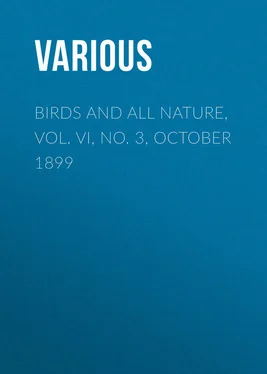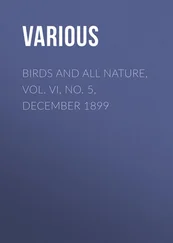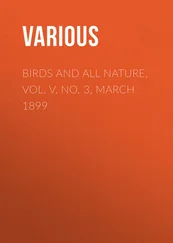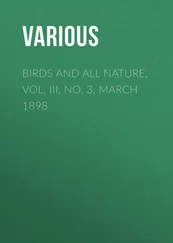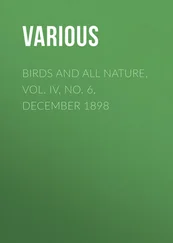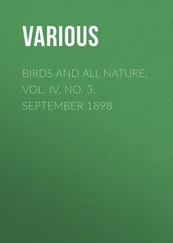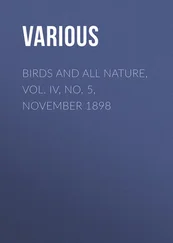Various - Birds and All Nature, Vol. VI, No. 3, October 1899
Здесь есть возможность читать онлайн «Various - Birds and All Nature, Vol. VI, No. 3, October 1899» — ознакомительный отрывок электронной книги совершенно бесплатно, а после прочтения отрывка купить полную версию. В некоторых случаях можно слушать аудио, скачать через торрент в формате fb2 и присутствует краткое содержание. Жанр: periodic, Биология, Природа и животные, foreign_edu, на английском языке. Описание произведения, (предисловие) а так же отзывы посетителей доступны на портале библиотеки ЛибКат.
- Название:Birds and All Nature, Vol. VI, No. 3, October 1899
- Автор:
- Жанр:
- Год:неизвестен
- ISBN:нет данных
- Рейтинг книги:3 / 5. Голосов: 1
-
Избранное:Добавить в избранное
- Отзывы:
-
Ваша оценка:
- 60
- 1
- 2
- 3
- 4
- 5
Birds and All Nature, Vol. VI, No. 3, October 1899: краткое содержание, описание и аннотация
Предлагаем к чтению аннотацию, описание, краткое содержание или предисловие (зависит от того, что написал сам автор книги «Birds and All Nature, Vol. VI, No. 3, October 1899»). Если вы не нашли необходимую информацию о книге — напишите в комментариях, мы постараемся отыскать её.
Birds and All Nature, Vol. VI, No. 3, October 1899 — читать онлайн ознакомительный отрывок
Ниже представлен текст книги, разбитый по страницам. Система сохранения места последней прочитанной страницы, позволяет с удобством читать онлайн бесплатно книгу «Birds and All Nature, Vol. VI, No. 3, October 1899», без необходимости каждый раз заново искать на чём Вы остановились. Поставьте закладку, и сможете в любой момент перейти на страницу, на которой закончили чтение.
Интервал:
Закладка:
Various
Birds and All Nature, Vol. VI, No. 3, October 1899
FORESTS
FORESTS have always been admired, and in ancient times they were often considered sacred, the special dwelling-places of gods and various strange beings. We can easily understand how forests thus affected men. There is a solemnity about them, a quiet grandeur, which is very impressive, and the rustling of their branches and leaves has that mysterious sound which caused the ancients to people them with spirits. We still recognize the feeling of awe that comes in the presence of forests, although we have long since ceased to explain it by peopling them with spirits.
Once forests covered all parts of the earth where plants could grow well, and no country had greater forests than North America. When America was discovered, there was a huge, unbroken forest from the Atlantic west to the prairies. Now much of this has been cut away, and we see only small patches of it. Men must use the forest, and still they must save it, and they are now trying to find out how they may do both.
Forests are sometimes almost entirely made up of one kind of tree, and then they are called "pure forests." Pine and beech forests are examples of this kind. More common with us, however, are the "mixed forests," made up of many kinds of trees, and nowhere in the world are there such mixed forests as in our Middle States, where beech, oak, hickory, maple, elm, poplar, gum, walnut, sycamore, and many others all grow together.
Probably the densest forests in the world are those in the Amazon region of South America. So dense are they that hardly a ray of light ever sifts through the dense foliage, and even at noon there is only a dim twilight beneath the trees. The tallest forests are the Eucalyptus forests of Australia, where the trees rise with slender trunks to the height of four or five hundred feet. But the largest trees in the world, when we consider both height and diameter, are the giant "redwoods" (Sequoias) of the Pacific coast. All concede, however, that the most extensive, the most varied, and the most beautiful forests of the world are those of the Atlantic and Middle States.
Perhaps it is well to understand how a tree lives, that we may know better what a forest means. The great roots spread through the soil, sometimes not far from the surface, at other times penetrating deeply. The young root tips are very sensitive to the presence of moisture, and turn towards it, no matter in what direction it may carry them. In penetrating the soil the sensitive root tips are turned in every direction by various influences of this kind, and as a result, when the root system becomes old, it looks like an inextricable tangle. All this tangle, however, but represents the many paths that the root tips followed in their search for the things which the soil contains.
Roots are doing two things for the tree: They anchor it firmly in the soil, and also absorb material that is to help in the manufacture of food. It is the older roots that have long since stopped absorbing that are the chief anchors. How firm this anchorage must be we can, perhaps, imagine when we think of the strain produced by a great crown of leaves swaying back and forth in the wind. It is only a cyclone that seems to be able to overthrow a sound tree, and then it more commonly breaks its trunk than uproots it.
The very important work of absorbing is given over to the very young roots; in fact, chiefly to those of this year, for new rootlets must be put out each year. These roots can only absorb water, so that if they are to get anything from the soil it must be something that water will dissolve. In this way the water is used as the carrier of soil-material into the root. Just how this water carrying soil-material gets into the root is not easy to explain, for the root has no holes to let it in, and it must pass through living walls. That it does enter, however, every one knows. It is evident, therefore, that the root is supplying to the tree two kinds of raw material for food manufacture obtained from the soil, namely, water and soil-material dissolved in it.
But the tree does not obtain all its raw material from the soil. A very important material is taken from the air, the material commonly called "carbonic acid gas," the same material that we breathe out so abundantly from our lungs as one of our body wastes. This important material is taken out of the air into the plant chiefly by means of the leaves. Spread out as they are in the air, the leaves are in the most favorable position for doing this work.
But where and how are these three kinds of raw material manufactured into plant food? The leaves are specially constructed to be the chief seat of this food manufacture. The carbon gas is received directly into these manufactories from the air, but the water and the soil-material are down in the roots, and it is necessary for them to be carried to the leaves. As a consequence, a "current" of water containing soil-material ascends from the roots, through the stem, and is distributed through the branches to the leaves. This movement is generally known as the "ascent of sap." The path of this movement in the stem is through what is known as the "sap wood," and it is this very fact which gives to this region of the wood its peculiar character. Just how the sap ascends through the stem and reaches the leaves, no one knows. All of our explanations have proved unsatisfactory, and only those who are not fully acquainted with the facts claim to be able to explain it.
When the sap reaches the leaves, the water is no longer needed as a carrier of soil-material. Some of it is needed in the manufacture of food, but by far the greater part of it escapes from the leaves into the air by a process which may be called "plant evaporation." The amount of water thus brought from the soil and poured out into the air by active plants is very great; and when we consider a forest at work, we can hardly compute the vast amount of moisture which it is constantly contributing to the air during the growing season.
The three kinds of raw material thus brought together chiefly in the leaves are there manufactured into plant food. On account of this work the leaves have often been spoken of as the "stomachs" of the plant. This is a very incorrect and misleading illustration, for the work referred to is not digestion such as a stomach is concerned with, and, in fact, it is a process entirely unknown in animals, and found only in green plants. It is a wonderful process, which we do not at all understand, but it consists in taking this dead raw material from soil and air and manufacturing out of it living material. Not only does the food of the plant, and hence its life, depend upon this process, but all the life of the world, as we understand it, depends upon it. We know at least two prominent conditions of this process, for it seems evident that it cannot take place without light and the peculiar green substance which gives the characteristic color to leaves. With the help of light and this green coloring substance, known as "chlorophyll," the living substance in the leaves is able to do this marvelous work.
The food thus manufactured is distributed throughout the tree, either to be used wherever growth is going on, or to be stored up. While we may say that there is an "ascending current" of sap through the sap wood, it is an error to say that there is a "descending current." The movement of prepared food has no definite channel, but it is drawn in every direction wherever needed.
If we now consider the parts of a tree all together, we may be able to get some notion of the meaning of their positions. The roots must be related to the soil to secure anchorage and raw material for food manufacture. The leaves must be related to the air and light to secure more raw material and help in doing their important work of food manufacture. The stem is simply to carry the leaves well up into the air and sunshine, and has no meaning except as it is related to the work of the leaves. In thus widely separating the roots and the leaves, the stem must act as a channel of communication between them.
Читать дальшеИнтервал:
Закладка:
Похожие книги на «Birds and All Nature, Vol. VI, No. 3, October 1899»
Представляем Вашему вниманию похожие книги на «Birds and All Nature, Vol. VI, No. 3, October 1899» списком для выбора. Мы отобрали схожую по названию и смыслу литературу в надежде предоставить читателям больше вариантов отыскать новые, интересные, ещё непрочитанные произведения.
Обсуждение, отзывы о книге «Birds and All Nature, Vol. VI, No. 3, October 1899» и просто собственные мнения читателей. Оставьте ваши комментарии, напишите, что Вы думаете о произведении, его смысле или главных героях. Укажите что конкретно понравилось, а что нет, и почему Вы так считаете.
